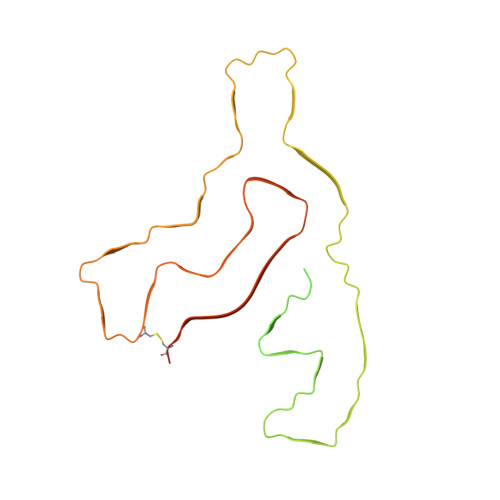Age-dependent formation of TMEM106B amyloid filaments in human brains.
Schweighauser, M., Arseni, D., Bacioglu, M., Huang, M., Lovestam, S., Shi, Y., Yang, Y., Zhang, W., Kotecha, A., Garringer, H.J., Vidal, R., Hallinan, G.I., Newell, K.L., Tarutani, A., Murayama, S., Miyazaki, M., Saito, Y., Yoshida, M., Hasegawa, K., Lashley, T., Revesz, T., Kovacs, G.G., van Swieten, J., Takao, M., Hasegawa, M., Ghetti, B., Spillantini, M.G., Ryskeldi-Falcon, B., Murzin, A.G., Goedert, M., Scheres, S.H.W.(2022) Nature 605: 310-314
- PubMed: 35344985
- DOI: https://doi.org/10.1038/s41586-022-04650-z
- Primary Citation of Related Structures:
7QVC, 7QVF, 7QWG, 7QWL, 7QWM - PubMed Abstract:
Many age-dependent neurodegenerative diseases, such as Alzheimer's and Parkinson's, are characterized by abundant inclusions of amyloid filaments. Filamentous inclusions of the proteins tau, amyloid-β, α-synuclein and transactive response DNA-binding protein (TARDBP; also known as TDP-43) are the most common 1,2 . Here we used structure determination by cryogenic electron microscopy to show that residues 120-254 of the lysosomal type II transmembrane protein 106B (TMEM106B) also form amyloid filaments in human brains. We determined the structures of TMEM106B filaments from a number of brain regions of 22 individuals with abundant amyloid deposits, including those resulting from sporadic and inherited tauopathies, amyloid-β amyloidoses, synucleinopathies and TDP-43 proteinopathies, as well as from the frontal cortex of 3 individuals with normal neurology and no or only a few amyloid deposits. We observed three TMEM106B folds, with no clear relationships between folds and diseases. TMEM106B filaments correlated with the presence of a 29-kDa sarkosyl-insoluble fragment and globular cytoplasmic inclusions, as detected by an antibody specific to the carboxy-terminal region of TMEM106B. The identification of TMEM106B filaments in the brains of older, but not younger, individuals with normal neurology indicates that they form in an age-dependent manner.
- Medical Research Council Laboratory of Molecular Biology, Cambridge, UK.
Organizational Affiliation:
















